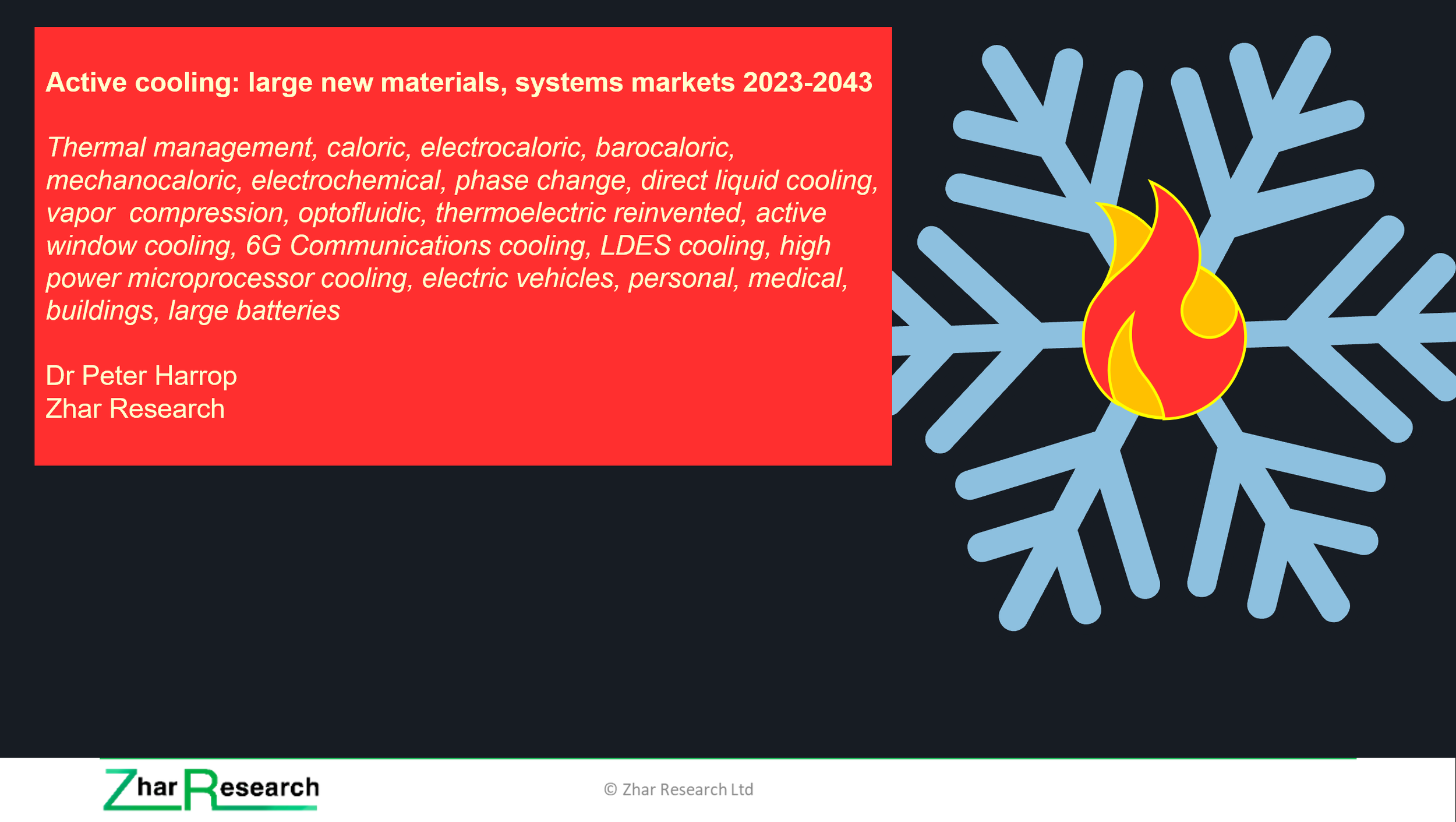New report on major new active cooling markets and technologies
Global warming drives the need for much more cooling technology but so does forthcoming equipment such as kW level microprocessors, 6G Communications, electric vehicles and planned long duration energy storage using compressed or liquid air. The new 270-page Zhar Research report, “Active cooling: large new materials, systems markets 2023-2043” has the latest information and analysis of the technologies and major markets arriving, creating billion dollar enterprises.
Traditional cooling and thermal management is either inadequate or unsustainable for most of these needs. Fortunately there is a rich research pipeline of new active (powered) cooling and temperature-holding technologies from twistocaloric, ionocaloric, switchable optofluidic and electrochemical to thermoelectrics reinvented and even arriving technologies for powered cooling smart windows. There is much more. In the meantime, air cooling is being reinvented and direct liquid cooling is rapidly gaining adoption in many sizes and with new materials. How, where, why? Why the electrocaloric enthusiasm?
This report is commercially-oriented critically assessing and predicting tracking all these topics for 2023-2043 with up-to-date inputs, much from 2023. It is primarily intended to provide all in the value chain of active (powered) cooling materials and systems with their opportunities from 2023-2043.
Being analysis not evangelism, it reveals emerging competition and markets going down as well as ones rising. It reveals sectors where less cooling will be needed in future and where passive cooling replaces active cooling. However, mostly it is able to reveal many sectors and technologies where billion dollar new businesses will be created that provide active cooling materials and systems. By a detailed examination of the research pipeline, it recommends a large number of the best research reports for further reading. See the most potentially impactful value-added cooling materials and the most important new cooling principles emerging. There is a roadmap of new market arrivals, technology advances and commercialisation 2023-2043 and their likely impact plus many market forecasts.
In short, this report will be very useful for all from value added materials suppliers to product and system integrators and users. It reveals gaps in the market and emerging competition and the applicational scope is wide, though it is impossible to cover everything in this rapidly evolving field. There are 98 new infograms, tables and images, 28 yearly forecasts 2023-2043, seven other and six SWOT appraisals.
The Executive Summary and Conclusions is sufficient for those needing the whole picture rapidly. Its 60 pages provide easy yet deeply informative basics, technology and market comparisons, forecasts, roadmaps.
Chapter 2 at 48 pages addresses cooling problems that are emerging opportunities 2023-2043, explaining different types of need for cooling people or things, emerging severe needs and potentially large markets for solutions to these. See types of cooling and their limitations: passive, active and their subsets with examples of limitations of certain cooling principles. The subject is brought to life with thermal consideration of NEOM smart city, future buildings, windows, greenhouses, refrigerators, freezers, electric vehicles, large batteries for vehicles, microgrids, grids and cooling new massive grid Long Duration Energy Storage LDES processes. We also introduce the new challenges (opportunities) with large processors, power electronics for grids, microgrids, vehicles and telecommunications such as planned 6G Communications, other electronics, ICT including data centers, solar panels, apparel, wearables, food supply chains and medical.
The 35 pages of Chapter 3 “Active cooling reinvented: buildings, windows, fans” includes finding air conditioner alternatives that are lower power, greener, more affordable with a lesson of failure profiled. The technology and potential of powered windows and facades that cool or prevent heat on demand. Here are critiques of radiative electrochromism, switchable optofluidics, multimode optofluidics, switchable phase change reflection, electricity from electrochromics and the “Acoustic Friendly Ventilation Window AFVW” – a smart fan approach leading to more on fan cooling reinvented – phone to subway – and including nano blowing and tiny new smartphone fans. It ends with expected extra cooling demand in 6G Communications infrastructure and client devices and a SWOT appraisal of this.
Chapter 4 is “Active cooling reinvented: Large batteries for land, water and airborne vehicles, microgrids, grids and the emerging Long Duration Energy Storage LDES”. In 40 detailed pages it looks closely at these needs with today’s solutions and a glimpse of where we are headed with three SWOT appraisals and new infograms.
After those chapters looking at new markets with examples of appropriate technologies, the last two chapters deep dive specifically into new technologies including materials opportunities arising. Chapter 5. takes 46 pages to cover “New arrivals: caloric and electrochemical cooling and temperature control”. Navigate the thicket of magnetocaloric, elastocaloric, twistocaloric, barocaloric, ionocaloric and electrochemical cooling and see why the research pipeline is richest for electrocaloric and why Zhar Research considers this to be appropriate, giving views of what it will achieve when commercialised.
The report ends with the 26 page chapter, “Thermoelectric cooling reinvented” – something of a surprise, because this old technology has radically new options arriving that may make it viable for large area, high power, better cooling of small things – its current heartland. Learn thermal switching with ferrons, spin-driven thermoelectrics, non-toxic and stronger-performance thermoelectric materials and more with many of the companies involved being listed. Indeed, this unique report mentions over 120 companies and the selected best research papers cited run to over 50.

